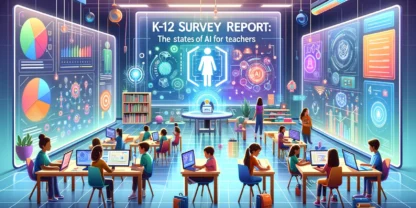The addition of writing to eSpark’s curriculum marks one of the most anticipated product enhancements in recent history. This AI-powered approach will empower students to grow as writers without any additional dedicated instructional time from teachers. As with the rest of eSpark’s curriculum, our writing pedagogy is rooted in the science of how we learn. Read on for more details about the research-based principles that drove the design and development of eSpark Writing.
1. Gradual Release of Responsibility
Fisher, D., & Frey, N. (2008). Better Learning Through Structured Teaching: A Framework for the Gradual Release of Responsibility, 3rd Edition. Alexandria, VA: ASCD.
If this looks familiar, it’s because the Gradual Release of Responsibility (GRR) Instructional Framework is widely used across subjects and grade levels. It’s the basis of the “I do, we do, you do” approach that is already a core part of eSpark’s lesson sequencing. When applied specifically to eSpark Writing, this principle will manifest in different ways based on the grade level students are working in and the skill being practiced.
In general terms, the writing process will be introduced in phases. With this initial release, students begin by choosing the topic they want to write about and generating an informational text about that topic. The eSpark “writing buddy” bot gives students several prompts to choose from based on that text. From there, the writing buddy guides the student through the writing process, providing gentle hints and nudges to get them on the right track.
The activity is not finished until the student has drafted a response that fits the prompt. A brief post-writing assessment verifies conceptual understanding before the student moves on. This iterative process will continuously build on itself until students are comfortable responding to prompts with minimal feedback between initial draft and publication.
2. Teach Students to Emulate the Features of Good Writing
Graham, S., et. al. (2018). Teaching Elementary School Students to Be Effective Writers. What Works Clearinghouse for the National Center for Education Evaluation and Regional Assistance, Institution of Education Sciences. Retrieved January 2024 from the IES website.
Per the What Works Clearinghouse panel of writing experts, “Students should be exposed to exemplary texts from a variety of sources…[Including] texts that support the instructional goals of the lesson, are appropriate for the students’ reading levels and abilities, and provide exemplary models of what students will write.”
eSpark Writing leverages the existing differentiation of Choice Texts to ensure students are working from text that is not only on-level, but also relevant and high-interest. Our rigorous prompt engineering and rubric-based text generation results in informational texts that clearly model the elements of strong, clear, and focused writing. Students use annotation tools to highlight key passages and repeatedly refer back to the example text for evidence and inspiration.
The preparation and drafting stages of eSpark Writing are also designed to point students toward best practices for sentence structure, relevance, and accuracy. The eSpark “writing buddy” bot provides real-time instruction to help students emulate good writing with each revision along the way.
3. Integrate Reading and Writing
Slavin, E.R., Lake, C., Inns, A., Baye, A., Dachet, D., Haslam, J. (2019). A Quantitative Synthesis of Research on Writing Approaches in Years 3 to 13. London: Education Endowment Foundation. Retrieved January 2024 from eric.ed.gov.
In this meta-analysis of multiple studies spanning various takes on writing instruction, researchers looked at “programmes explicitly designed to teach literacy as a unified whole…For example, such programmes often have students write about texts they have read, and forming arguments based on evidence.”
This overarching concept of treating reading and writing not as two separate disciplines, but rather as two interconnected components of literacy, was one of the pillars of our design and development strategies for eSpark Writing. It was important to us that students were able to write not just as a skill-building exercise in a vacuum, but as a way of making connections with texts. As outlined in EdWeek’s How Does Writing Fit Into the ‘Science of Reading?, we are drawing on the evidence suggesting “that writing can be a useful tool to help students explore, deepen, and draw connections in [their] content.”

In this example, our student has chosen to write about one of their favorite YouTubers, Mr. Beast. Through the writing process, they elaborate on a specific part of the reading informational text they’re working from by revisiting the text and using evidence to support their thoughts on it. The end result is a deeper understanding of the original topic, and an opportunity for students to give voice to why it’s important to them in the first place.
With eSpark, students aren’t just learning to write. They’re also writing to learn.
4. Productive Struggle and Real-Time Explanations (With an AI Twist)
Kumar, Harsh and Rothschild, David M. and Goldstein, Daniel G. and Hofman, Jake. (2023). Math Education with Large Language Models: Peril or Promise? University of Toronto and Microsoft Research. Retrieved January 2024 from https://ssrn.com/abstract=4641653
Although this study focused specifically on math instruction, the insights gleaned from the research offer some cautiously optimistic signals about the efficacy of AI tutors. Researchers gave math problems to 1,200 participants, with the test group receiving large language model (LLM)-generated explanations of the answers. The study gave us two big takeaways:
- LLM-based explanations had a positive impact on learning relative to just showing the participant the correct answer.
- The benefits were largest for those who attempted problems on their own first before consulting the LLM explanations.
These results might seem like common sense. Of course people learn more when they are explicitly taught how to arrive at the correct answer. Productive struggle has long been recognized as a valuable learning technique as well. But to see peer-reviewed validation that LLMs can fill this critical role in instruction is a step further than simply assuming it to be true.
eSpark Writing leverages these same concepts in two unique ways. First, we encourage students to attempt writing on their own by centering the writing around topics they choose, read, and care about. Second, our writing tutor bot guides students along the writing process by explicitly explaining how they can improve. This approach that previously would have required 1:1 teacher intervention is now fully automated, removing a huge barrier to dedicated writing instruction in the classroom.
Full-Spectrum Personalization, Grounded in Science
eSpark is thrilled to add writing to our curriculum mix, not just because it gives eSparkers another reason to use the program, but because it also fills one of the biggest gaps in most classroom routines. Many studies have recommended as much as one hour per day dedicated to writing, but the reality is that the majority of teachers we surveyed are lucky to fit in that much time in an entire week.
By differentiating instruction at all three levels: learning paths based on student levels, content based on student interests, and instruction and feedback based on student responses, eSpark offers teachers a supplement to core curriculum that ticks every box of what personalized learning should be. It’s not just cutting-edge technology, it’s cutting-edge technology that will always be aligned with the science of how we learn.
Until next time, happy eSparking!



